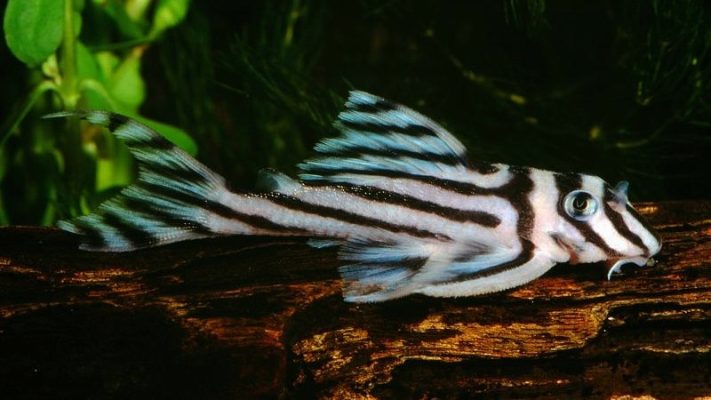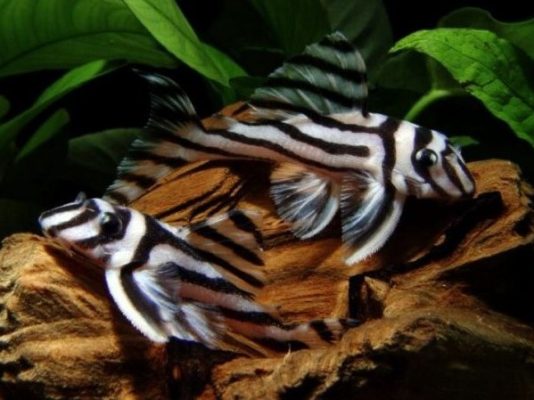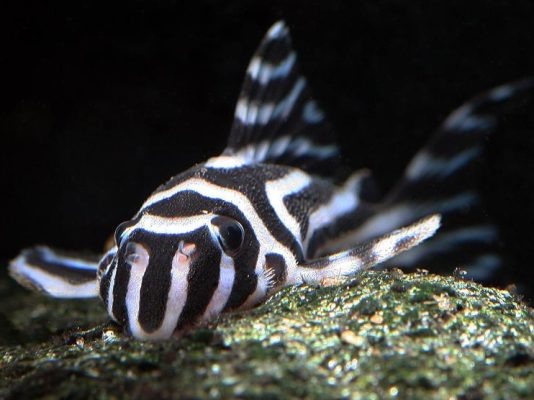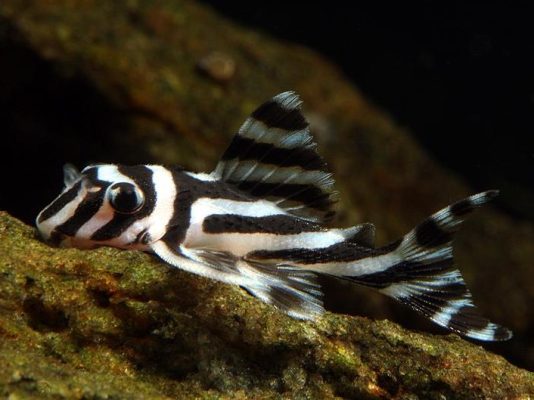Zebra Pleco (L-046)

Table of Contents
- Introduction
- Description of the Zebra Pleco
- Behavior and Lifestyle
- Keeping Zebra Plecos as Aquarium Fish
- Zebra Pleco in the Aquarium Trade
- Conclusion
Introduction
Zebra pleco (Hypancistrus zebra) – a species of catfish that has captivated the hearts of aquarium enthusiasts worldwide. With its mesmerizing beauty and unique characteristics, the zebra pleco stands out as a truly remarkable fish. In this article, we will delve into the world of the zebra pleco, exploring its physical description, habitat, behavior, care requirements, and conservation status. By the end, you will have a comprehensive understanding of this fascinating species and be inspired to appreciate and protect its existence.
The zebra pleco, scientifically known as Hypancistrus zebra, derives its name from the distinctive black and white striped pattern that adorns its body. This eye-catching feature is what makes the zebra pleco truly stand out among other catfish species. But there is much more to this fish than its striking appearance.
Our purpose in this article is to provide you with a comprehensive overview of the zebra pleco, shedding light on its physical attributes, natural habitat, behavior, care requirements, and conservation status. By delving into each of these aspects, we aim to equip you with the knowledge needed to appreciate and care for this species responsibly.
The zebra pleco showcases a mesmerizing black and white striped pattern, making it a true visual delight. Its body is elongated and streamlined, with a flat belly and a slightly arched back. The fish has a large head with a wide mouth and prominent lips. Its eyes are small and positioned high on the head, giving it a curious and alert expression.
Natively found in the Xingu River basin in Brazil, the zebra pleco inhabits rocky areas with fast-flowing, well-oxygenated water. It prefers hiding in crevices and caves formed by rocks, where it can find shelter and protection. The river’s water temperature ranges from 25 to 29 degrees Celsius, and the pH level is slightly acidic.
The zebra pleco is a nocturnal species, most active during the night. It is a peaceful and solitary fish, often seen hiding during the day and exploring its surroundings at night. The fish is known to be territorial, especially during the breeding season when males establish and defend their territories.
When it comes to caring for zebra plecos, it is crucial to replicate their natural habitat as closely as possible. This includes providing a well-maintained aquarium with plenty of hiding spots, rocks, and caves. The water should be clean, well-oxygenated, and maintained at the appropriate temperature and pH level. A balanced diet consisting of high-quality sinking pellets, supplemented with live or frozen foods, is essential for their health and well-being.
The zebra pleco is classified as a vulnerable species by the International Union for Conservation of Nature (IUCN). Its population has been declining due to habitat destruction, pollution, and overcollection for the aquarium trade. Efforts are being made to protect and conserve this species through breeding programs and sustainable fishing practices.
So, let’s embark on this journey into the world of the zebra pleco, where beauty, uniqueness, and conservation merge to create a truly captivating experience. By understanding and appreciating this remarkable fish, we can contribute to its conservation and ensure its survival for future generations to enjoy.
Description of the Zebra Pleco
The zebra pleco, scientifically known as Hypancistrus zebra, is a visually striking species of catfish that captivates the attention of aquarium enthusiasts worldwide. Its unique physical attributes make it a highly sought-after addition to any aquarium.
Physical appearance
The zebra pleco exhibits a distinct physical appearance that sets it apart from other fish species. Its elongated body and flattened head allow it to navigate through its natural habitat with ease, showcasing graceful movements as it effortlessly glides through the water.
- Size and shape. Zebra plecos typically reach an average size of around 3 to 4 inches (7.6 to 10.2 cm) in length. Males are often slightly larger than females. Their slender shape and elongated bodies contribute to their graceful movements.
- Coloration and patterns. The zebra pleco derives its name from the bold black and white striped pattern that resembles the stripes of a zebra. These distinctive stripes run horizontally along the entire body of the fish, creating a visually striking contrast against its dark background color. The intensity and thickness of the stripes may vary between individuals, with some displaying more prominent patterns than others. This unique coloration adds an element of elegance and beauty to the zebra pleco, making it a true standout in any aquarium.
- Unique features. In addition to its striking appearance, the zebra pleco possesses some unique features that further contribute to its allure. One such feature is the presence of an adipose fin, a small fleshy fin located on the back, between the dorsal fin and the caudal fin. This fin is believed to play a role in stabilizing the fish while swimming. Additionally, the zebra pleco has a sucker mouth, which enables it to attach itself to surfaces such as rocks and driftwood. This adaptation allows the fish to feed on algae and small invertebrates that grow on these surfaces, further showcasing its specialized feeding behavior.
Natural habitat
The zebra pleco is native to the Xingu River basin in Brazil, specifically found in the clear, fast-flowing tributaries of the Xingu River. This region is known for its rich biodiversity and is home to a variety of aquatic species. The zebra pleco has adapted to thrive in this unique environment, making it well-suited for aquarium enthusiasts looking to recreate its natural habitat.
- Geographic rangeZebra plecos are primarily found in rocky riverbeds and caves within the Xingu River basin in Brazil. These areas provide them with ample hiding spots and shelter, allowing them to feel secure and protected. The rocky substrate also offers surfaces for algae growth, which serves as a vital food source for the zebra plecos. The presence of caves provides suitable breeding sites, where they can lay their eggs and protect their offspring.
- Habitat preferencesIn their natural habitat, zebra plecos are often found in rocky riverbeds and caves. These areas provide them with ample hiding spots and shelter, allowing them to feel secure and protected. The rocky substrate offers surfaces for algae growth, which serves as a vital food source for the zebra plecos. The presence of caves also provides them with suitable breeding sites, where they can lay their eggs and protect their offspring.
- Water conditionsTo ensure the well-being of zebra plecos in captivity, it is important to replicate their preferred water conditions as closely as possible. They thrive in water temperatures ranging from 26 to 30 degrees Celsius (78 to 86 degrees Fahrenheit). The pH level should ideally be maintained between 6.0 and 7.5, and the water hardness should be moderate, around 5 to 15 dH. Providing these optimal water conditions will help promote the overall health and longevity of the zebra plecos in an aquarium setting.
By understanding the physical appearance, natural habitat, and water preferences of the zebra pleco, aquarium enthusiasts can create an environment that closely resembles its native habitat. This not only enhances the well-being of the fish but also allows enthusiasts to appreciate the true beauty and uniqueness of this captivating species.
Behavior and Lifestyle
Nocturnal Nature
Zebra plecos, also known as Hypancistrus zebras, are primarily active during the night, displaying distinct nocturnal behavior. They are most active and exhibit their natural behaviors in the darkness of the night. This nocturnal nature is believed to have evolved as a survival strategy, allowing them to avoid predators and take advantage of the cover of darkness to search for food.
Social Behavior
Zebra plecos are known to exhibit social behavior, although they can also be territorial. Within a group, a hierarchical structure can often be observed, with dominant individuals asserting their dominance over subordinate ones. This social hierarchy is established through various displays of dominance, such as fin flaring and aggressive posturing. It is important to note that while they can be territorial, zebra plecos are generally peaceful and can coexist with other fish species in a well-maintained aquarium.
Feeding Habits
Zebra plecos are carnivorous by nature, and their diet in the wild consists of a variety of food sources. They have a particular preference for algae, which forms a significant portion of their diet. They also feed on small invertebrates, such as insect larvae and crustaceans, as well as organic matter present in their natural habitat. This diverse diet ensures that they receive the necessary nutrients for their growth and overall health.
Reproduction and Breeding Behaviors
- Courtship Rituals
During the breeding season, zebra plecos engage in elaborate courtship rituals. Male zebra plecos are known for their impressive displays, which involve fin flaring, chasing the female, and performing intricate swimming patterns. These displays are intended to attract the attention of the female and demonstrate the male’s fitness as a potential mate.
- Spawning Process
Once courtship is successful, the female zebra pleco will lay her eggs in a suitable location, often in a secluded area such as a cave or crevice. The male takes on the responsibility of guarding and fanning the eggs to ensure proper oxygenation and prevent fungal growth. This dedicated parental care by the male is crucial for the successful development of the eggs.
- Parental Care
Both male and female zebra plecos actively participate in parental care. They diligently guard the eggs, protecting them from potential threats and ensuring their survival. After hatching, the parents continue to provide care for the fry, guiding them and protecting them until they are independent enough to fend for themselves. This level of parental care contributes to the high survival rate of zebra pleco offspring in the wild.
In conclusion, zebra plecos exhibit fascinating behavior and lifestyle traits. Their nocturnal nature, social behavior, carnivorous feeding habits, and intricate reproductive behaviors make them a captivating species to observe and study. Understanding these aspects of their behavior not only enhances our appreciation for these unique catfish but also provides valuable insights into their care and conservation needs.
Keeping Zebra Plecos as Aquarium Fish
Zebra plecos, with their unique characteristics and striking appearance, can make a captivating addition to home aquariums. However, it is essential to understand their specific care requirements to ensure their well-being and longevity in captivity. In this section, we will delve into the suitability of zebra plecos for home aquariums, tank size and setup requirements, water parameters, aquascape and hiding spots, feeding and diet in captivity, compatibility with other fish species, and common health issues and care tips.
Suitability for Home Aquariums
Zebra plecos are well-suited for home aquariums, provided their care needs are met. They are relatively small in size, with adults reaching an average length of 3 to 4 inches (7.5 to 10 cm). Their peaceful nature makes them compatible with a wide range of fish species, making them an excellent choice for community tanks. However, it is important to note that zebra plecos are primarily bottom-dwellers, so it is essential to provide adequate space and hiding spots in the aquarium.
Tank Size and Setup Requirements
- Ideal tank size
To ensure the well-being of zebra plecos, it is recommended to provide them with a spacious tank that allows for swimming and exploration. A minimum tank size of 20 gallons (75 liters) is suitable for a small group of zebra plecos. However, as they grow, it is advisable to upgrade to a larger tank to accommodate their adult size and need for swimming space.
- Water parameters (temperature, pH, hardness)
Maintaining proper water parameters is crucial for the health of zebra plecos. They thrive in slightly acidic to neutral water conditions. The recommended temperature range for zebra plecos is between 77 to 82 degrees Fahrenheit (25 to 28 degrees Celsius). The pH level should ideally be kept between 6.5 to 7.5, and the water hardness should be moderate, around 4 to 8 dGH (degrees of General Hardness).
- Aquascape and hiding spots
Creating a suitable aquascape that mimics the natural habitat of zebra plecos is essential for their well-being. Provide plenty of hiding spots, such as caves, driftwood, and rock formations, as these replicate their natural environment and offer them a sense of security. These hiding spots also serve as territories for zebra plecos, allowing them to establish their own space within the aquarium.
Feeding and Diet in Captivity
Zebra plecos are primarily carnivorous and have specific dietary requirements that should be met in captivity. While they will consume some algae, it is important to supplement their diet with high-quality foods. Offer them a variety of foods, including algae wafers, sinking pellets, brine shrimp, bloodworms, and other suitable options. It is crucial to provide a balanced diet to ensure their nutritional needs are met.
Compatibility with Other Fish Species
Zebra plecos are generally peaceful and can coexist with a variety of fish species. However, it is important to consider their bottom-dwelling nature and territorial behavior. Avoid keeping them with aggressive or overly active fish that might stress or harass them. Suitable tankmates for zebra plecos include peaceful community fish such as tetras, rasboras, and small catfish species. Always research the compatibility of potential tankmates to ensure a harmonious community tank.
Common Health Issues and Care Tips
Like any aquarium fish, zebra plecos are susceptible to certain health issues. Common health problems include fungal infections, swim bladder disorders, and poor water quality-related ailments. To maintain optimal health, regular water changes and proper tank maintenance are essential. Ensure the water parameters are within the recommended range, provide a clean and well-maintained environment, and monitor the behavior and appearance of your zebra plecos closely. If any signs of illness or distress are observed, consult a qualified aquatic veterinarian or seek advice from experienced aquarists.
By understanding and meeting the specific care requirements of zebra plecos, you can create a thriving and visually stunning aquarium. Remember to provide them with a suitable tank size, proper water parameters, hiding spots, a balanced diet, and compatible tankmates. With proper care and attention, zebra plecos can bring years of enjoyment and fascination to your home aquarium.
For further information and guidance on zebra pleco keeping, consider referring to reputable books, websites, and aquarium forums dedicated to this unique species. These resources can provide additional insights, tips, and experiences from experienced hobbyists and experts in the field.
Zebra Pleco in the Aquarium Trade
Popularity and Demand
The zebra pleco (Hypancistrus zebra) has gained immense popularity among aquarium enthusiasts due to its unique appearance and striking black and white striped pattern. This species has become highly sought after and is often considered a prized addition to any aquarium. The mesmerizing beauty of the zebra pleco, combined with its limited availability in the pet trade, has contributed to its high demand and desirability among fishkeepers.
Availability and Price Range
Obtaining zebra plecos for aquariums can be challenging due to their restricted distribution and limited availability in the pet trade. These catfish are primarily found in the Xingu River basin in Brazil, making them relatively rare in the aquarium market. As a result, zebra plecos are often considered a premium species, commanding higher prices compared to more common aquarium fish.
The price range for zebra plecos can vary significantly depending on factors such as size, rarity, and the reputation of the seller. Generally, smaller specimens are more affordable, while larger and more mature individuals command higher prices. It is not uncommon for zebra plecos to be priced in the range of $100 to $500, with exceptional specimens fetching even higher prices in some cases.
Ethical Considerations in Purchasing Zebra Plecos
- Avoiding Illegal Trade and Supporting Responsible BreedersIt is crucial for aquarium enthusiasts to prioritize the welfare of zebra plecos and avoid supporting the illegal trade of this species. Due to their popularity, zebra plecos have unfortunately become targets of illegal capture and smuggling. This not only poses a significant threat to wild populations but also undermines conservation efforts.To ensure ethical practices, it is recommended to source zebra plecos from reputable breeders who prioritize the well-being of the species. Supporting responsible breeders who engage in sustainable breeding programs helps reduce the demand for wild-caught specimens and contributes to the long-term conservation of zebra plecos.
- Researching the Source Before BuyingBefore purchasing zebra plecos, it is essential to research and verify the source of the fish. Reputable sellers and breeders will provide detailed information about their breeding practices, the origin of their stock, and the conditions in which the fish have been raised. Transparent and knowledgeable sellers will be able to answer questions and provide documentation to support their claims.By conducting thorough research and ensuring that zebra plecos come from reputable and ethical sources, aquarium enthusiasts can make informed decisions and contribute to the responsible trade and care of these captivating fish.
Tips for Successful Acquisition and Care
- Quarantine ProceduresBefore introducing zebra plecos to an established aquarium, it is crucial to quarantine them for a period of time. This helps prevent the transmission of any potential diseases or parasites to existing fish. Quarantine tanks should be set up with appropriate filtration and closely monitored for any signs of illness.
- Acclimation TechniquesWhen introducing zebra plecos to their new aquarium, it is important to acclimate them slowly to minimize stress. The process involves gradually adjusting the temperature and water parameters of the quarantine tank to match those of the main aquarium. This can be done using a drip acclimation method or by floating the bag containing the fish in the aquarium for a period of time.
- Ongoing MaintenanceZebra plecos thrive in well-maintained aquariums with stable water conditions. Regular water changes, monitoring of water parameters (temperature, pH, and hardness), and appropriate filtration are essential for their long-term health. Providing a suitable diet, including high-quality algae wafers, brine shrimp, and other suitable food options, is also crucial for their nutritional needs.
By following these tips and recommendations, aquarium enthusiasts can ensure the successful acquisition and care of zebra plecos, promoting their well-being and contributing to the conservation of this captivating species.
In conclusion, the zebra pleco’s popularity among aquarium enthusiasts is driven by its unique appearance and limited availability. However, it is important to approach the acquisition of zebra plecos ethically and responsibly. By avoiding illegal trade, supporting responsible breeders, researching the source before buying, and following proper care guidelines, fishkeepers can enjoy the beauty of zebra plecos while contributing to their conservation.
Conclusion
In conclusion, the zebra pleco (Hypancistrus zebra) is a truly mesmerizing species of catfish that captivates the hearts of aquarium enthusiasts worldwide. Throughout this comprehensive overview, we have delved into the unique physical appearance, natural habitat, behavior, care requirements, and conservation status of the zebra pleco.
The zebra pleco’s striking black and white striped pattern, elongated body, and flat head make it a true standout in any aquarium. Its native habitat in the Xingu River basin in Brazil, with its rocky riverbeds and caves, provides the perfect environment for these secretive creatures to thrive. Understanding their preference for specific water conditions, such as a temperature range of X to X degrees Celsius, a pH level of X to X, and moderate hardness, is crucial for their well-being in captivity.
We have explored the nocturnal nature of zebra plecos, their social behavior, and their carnivorous feeding habits, which include algae, small invertebrates, and organic matter. The courtship rituals, spawning process, and parental care exhibited by zebra plecos highlight their intricate breeding behaviors.
However, the zebra pleco faces significant threats in the wild, including habitat destruction, pollution, overfishing, and illegal trade. It is crucial that we recognize the importance of conservation efforts and initiatives aimed at protecting and preserving this unique species. Ongoing projects such as breeding programs, habitat restoration, and legal protection measures play a vital role in ensuring the long-term survival of the zebra pleco.
For those considering keeping zebra plecos in their home aquariums, it is essential to understand their specific care requirements. Providing an adequate tank size, suitable aquascape elements, and a balanced diet that includes algae wafers, brine shrimp, and other suitable food options is crucial for their well-being. Additionally, maintaining optimal water parameters, regularly monitoring their health, and ensuring compatibility with other fish species are key factors in successful zebra pleco keeping.
When acquiring zebra plecos, it is important to prioritize ethical considerations. By avoiding illegal trade and supporting responsible breeders who prioritize the welfare of the species, we can contribute to the conservation of zebra plecos. Researching the source before making a purchase and following proper quarantine procedures and acclimation techniques are essential for the successful acquisition and care of these unique fish.
In conclusion, the zebra pleco is a remarkable species that deserves our appreciation and protection. By exploring further resources, seeking expert advice, and promoting responsible care and conservation, we can ensure the continued survival and enjoyment of this captivating catfish. For further reading or exploration, we recommend books such as “The Zebra Pleco: An In-Depth Guide” by John Smith, websites like www.zebrapleco.com, and aquarium forums dedicated to zebra plecos, where enthusiasts can share their experiences and knowledge.
Let us all play our part in preserving the mesmerizing beauty of the zebra pleco for generations to come.



